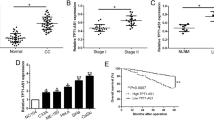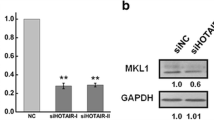Abstract
Long non‐coding RNA (lncRNA) Ewing sarcoma associated transcript 1 (EWSAT1) is an oncogene in a variety of tumors. Here, we planned to demonstrate EWSAT1 function in cervical cancer and further illustrate its underlying mechanism. EWSAT1 expression in cervical cancer was evaluated through qRT-PCR. Colony forming capacity was measured by colony formation assay and cell proliferation ability was measured by CCK-8 kit. Wound healing experiment was applied to test the cell migration and transwell assay was applied to test the invasion ability. Luciferase assay was employed to demonstrate EWSAT1 and miR-330-5p interaction. In cervical cancer, the expression of EWSAT1 was enhanced and contributed to the poor prognosis. Downregulated EWSAT1 expression inhibited Hela cell migration, proliferation, and invasion. EWSAT1 targeted to miR-330-5p and upregulated cytoplasmic polyadenylation element-binding protein 4 (CPEB4) expression by sponging miR-330-5p. Our study revealed that EWSAT1 enhances CPEB4 expression through sponging miR-330-5p, thereby promoting cervical cancer development, which might provide potential therapeutic targets for clinically cervical cancer patients.






Similar content being viewed by others
References
Boom K, Lopez M, Daheri M, Gowen R, Milbourne A, Toscano P, Carey C, Guerra L, Carvajal JM, Marin E, Baker E, Fisher-Hoch S, Rodriguez AM, Burkalter N, Cavazos B, Gasca M, Cuellar MM, Robles E, Lopez E, Schmeler K (2019) Perspectives on cervical cancer screening and prevention: challenges faced by providers and patients along the Texas-Mexico border. Perspect Public Health 139:199–205. https://doi.org/10.1177/1757913918793443
Morales-Campos DY, Snipes SA, Villarreal EK, Crocker LC, Guerrero A, Fernandez ME (2018) Cervical cancer, human papillomavirus (HPV), and HPV vaccination: exploring gendered perspectives, knowledge, attitudes, and cultural taboos among Mexican American adults. Ethn Health. https://doi.org/10.1080/13557858.2018.1494821
Chen L, Luan S, Xia B, Liu Y, Gao Y, Yu H, Mu Q, Zhang P, Zhang W, Zhang S, Wei G, Yang M, Li K (2018) Integrated analysis of HPV-mediated immune alterations in cervical cancer. Gynecol Oncol 149:248–255. https://doi.org/10.1016/j.ygyno.2018.01.031
Mabuchi S, Matsumoto Y, Komura N, Sawada M, Tanaka M, Yokoi E, Kozasa K, Yoshimura A, Kuroda H, Kimura T (2017) The efficacy of surgical treatment of recurrent or persistent cervical cancer that develops in a previously irradiated field: a monoinstitutional experience. Int J Clin Oncol 22:927–936. https://doi.org/10.1007/s10147-017-1134-x
Pereira E, Cooper HH, Zelaya PG, Creasman W, Price FV, Gupta V, Chuang L (2017) Concurrent chemoradiation versus radiotherapy alone for the treatment of locally advanced cervical cancer in a low-resource setting. Gynecol Oncol Rep 19:50–52. https://doi.org/10.1016/j.gore.2016.12.006
Menderes G, Black J, Schwab CL, Santin AD (2016) Immunotherapy and targeted therapy for cervical cancer: an update. Expert Rev Anticancer Ther 16:83–98. https://doi.org/10.1586/14737140.2016.1121108
Soudyab M, Iranpour M, Ghafouri-Fard S (2016) The role of long non-coding RNAs in breast cancer. Arch Iran Med 19:508–517
Ghafouri-Fard S, Taheri M (2019) Long non-coding RNA signature in gastric cancer. Exp Mol Pathol 113:104365. https://doi.org/10.1016/j.yexmp.2019.104365
Dey BK, Mueller AC, Dutta A (2014) Long non-coding RNAs as emerging regulators of differentiation, development, and disease. Transcription 5:e944014. https://doi.org/10.4161/21541272.2014.944014
Marques Howarth M, Simpson D, Ngok SP, Nieves B, Chen R, Siprashvili Z, Vaka D, Breese MR, Crompton BD, Alexe G, Hawkins DS, Jacobson D, Brunner AL, West R, Mora J, Stegmaier K, Khavari P, Sweet-Cordero EA (2014) Long noncoding RNA EWSAT1-mediated gene repression facilitates Ewing sarcoma oncogenesis. J Clin Invest 124:5275–5290. https://doi.org/10.1172/JCI72124
Fu X, Zhang L, Dan L, Wang K, Xu Y (2017) LncRNA EWSAT1 promotes ovarian cancer progression through targeting miR-330-5p expression. Am J Transl Res 9:4094–4103
Zhang GY, Zhang JF, Hu XM, Luo ZP, Ma YZ (2017) Clinical significance of long non-coding RNA EWSAT1 as a novel prognostic biomarker in osteosarcoma. Eur Rev Med Pharmacol Sci 21:5337–5341. https://doi.org/10.26355/eurrev_201712_13918
Sun L, Yang C, Xu J, Feng Y, Wang L, Cui T (2016) Long noncoding RNA EWSAT1 promotes osteosarcoma cell growth and metastasis through suppression of MEG3 expression. DNA Cell Biol 35:812–818. https://doi.org/10.1089/dna.2016.3467
Song P, Yin SC (2016) Long non-coding RNA EWSAT1 promotes human nasopharyngeal carcinoma cell growth in vitro by targeting miR-326/-330-5p. Aging (Albany NY) 8:2948–2960. https://doi.org/10.18632/aging.101103
Zhang R, Li JB, Yan XF, Jin K, Li WY, Xu J, Zhao J, Bai JH, Chen YZ (2018) Increased EWSAT1 expression promotes cell proliferation, invasion and epithelial-mesenchymal transition in colorectal cancer. Eur Rev Med Pharmacol Sci 22:6801–6808. https://doi.org/10.26355/eurrev_201810_16146
Ivshina M, Alexandrov IM, Vertii A, Doxsey S, Richter JD (2015) CPEB regulation of TAK1 synthesis mediates cytokine production and the inflammatory immune response. Mol Cell Biol 35:610–618. https://doi.org/10.1128/MCB.00800-14
Fernandez-Miranda G, Mendez R (2012) The CPEB-family of proteins, translational control in senescence and cancer. Ageing Res Rev 11:460–472. https://doi.org/10.1016/j.arr.2012.03.004
Wang XP, Cooper NG (2010) Comparative in silico analyses of cpeb1-4 with functional predictions. Bioinform Biol Insights 4:61–83. https://doi.org/10.4137/bbi.s5087
Ortiz-Zapater E, Pineda D, Martinez-Bosch N, Fernandez-Miranda G, Iglesias M, Alameda F, Moreno M, Eliscovich C, Eyras E, Real FX, Mendez R, Navarro P (2011) Key contribution of CPEB4-mediated translational control to cancer progression. Nat Med 18:83–90. https://doi.org/10.1038/nm.2540
Zhong X, Xiao Y, Chen C, Wei X, Hu C, Ling X, Liu X (2015) MicroRNA-203-mediated posttranscriptional deregulation of CPEB4 contributes to colorectal cancer progression. Biochem Biophys Res Commun 466:206–213. https://doi.org/10.1016/j.bbrc.2015.09.008
Wang HX, Qin R, Mao J, Huang QL, Hong F, Li F, Gong ZY, Xu T, Yan Y, Chao SH, Zhang SK, Chen JX (2018) CPEB4 regulates glioblastoma cell proliferation and predicts poor outcome of patients. Clin Neurol Neurosurg 169:92–97. https://doi.org/10.1016/j.clineuro.2018.04.008
Lu R, Zhou Z, Yu W, Xia Y, Zhi X (2017) CPEB4 promotes cell migration and invasion via upregulating Vimentin expression in breast cancer. Biochem Biophys Res Commun 489:135–141. https://doi.org/10.1016/j.bbrc.2017.05.112
Jiang H, Wang B, Gao Z, Song K (2018) The research progress of CPEB4 in tumor. Lin Chung Er Bi Yan Hou Tou Jing Wai Ke Za Zhi 32:1038–1033
Cortes-Guiral D, Pastor-Iodate C, Diaz Del Arco C, Del Puerto-Nevado L, Fernandez-Acenero MJ (2017) CPEB4 immunohistochemical expression is associated to prognosis in stage IV colorectal carcinoma. Pathol Res Pract 213:639–642. https://doi.org/10.1016/j.prp.2017.04.020
Parras A, Anta H, Santos-Galindo M, Swarup V, Elorza A, Nieto-Gonzalez JL, Pico S, Hernandez IH, Diaz-Hernandez JI, Belloc E, Rodolosse A, Parikshak NN, Penagarikano O, Fernandez-Chacon R, Irimia M, Navarro P, Geschwind DH, Mendez R, Lucas JJ (2018) Autism-like phenotype and risk gene mRNA deadenylation by CPEB4 mis-splicing. Nature 560:441–446. https://doi.org/10.1038/s41586-018-0423-5
Weber MJ (2005) New human and mouse microRNA genes found by homology search. FEBS J 272:59–73. https://doi.org/10.1111/j.1432-1033.2004.04389.x
Neville PJ, Conti DV, Krumroy LM, Catalona WJ, Suarez BK, Witte JS, Casey G (2003) Prostate cancer aggressiveness locus on chromosome segment 19q12-q13.1 identified by linkage and allelic imbalance studies. Genes Chromosomes Cancer 36:332–339. https://doi.org/10.1002/gcc.10165
Slager SL, Schaid DJ, Cunningham JM, McDonnell SK, Marks AF, Peterson BJ, Hebbring SJ, Anderson S, French AJ, Thibodeau SN (2003) Confirmation of linkage of prostate cancer aggressiveness with chromosome 19q. Am J Hum Genet 72:759–762. https://doi.org/10.1086/368230
Lee KH, Chen YL, Yeh SD, Hsiao M, Lin JT, Goan YG, Lu PJ (2009) MicroRNA-330 acts as tumor suppressor and induces apoptosis of prostate cancer cells through E2F1-mediated suppression of Akt phosphorylation. Oncogene 28:3360–3370. https://doi.org/10.1038/onc.2009.192
Mao Y, Chen H, Lin Y, Xu X, Hu Z, Zhu Y, Wu J, Xu X, Zheng X, Xie L (2013) microRNA-330 inhibits cell motility by downregulating Sp1 in prostate cancer cells. Oncol Rep 30:327–333. https://doi.org/10.3892/or.2013.2452
Qu S, Yao Y, Shang C, Xue Y, Ma J, Li Z, Liu Y (2012) MicroRNA-330 is an oncogenic factor in glioblastoma cells by regulating SH3GL2 gene. PLoS ONE 7:e46010. https://doi.org/10.1371/journal.pone.0046010
Yao Y, Xue Y, Ma J, Shang C, Wang P, Liu L, Liu W, Li Z, Qu S, Li Z, Liu Y (2014) MiR-330-mediated regulation of SH3GL2 expression enhances malignant behaviors of glioblastoma stem cells by activating ERK and PI3K/AKT signaling pathways. PLoS ONE 9:e95060. https://doi.org/10.1371/journal.pone.0095060
Feng L, Ma J, Ji H, Liu Y, Hu W (2017) miR-330-5p suppresses glioblastoma cell proliferation and invasiveness through targeting ITGA5. Biosci Rep. https://doi.org/10.1042/BSR20170019
Wei CH, Wu G, Cai Q, Gao XC, Tong F, Zhou R, Zhang RG, Dong JH, Hu Y, Dong XR (2018) Correction to: MicroRNA-330-3p promotes cell invasion and metastasis in non-small cell lung cancer through GRIA3 by activating MAPK/ERK signaling pathway. J Hematol Oncol 11:6. https://doi.org/10.1186/s13045-017-0546-4
Liu X, Shi H, Liu B, Li J, Liu Y, Yu B (2015) miR-330-3p controls cell proliferation by targeting early growth response 2 in non-small-cell lung cancer. Acta Biochim Biophys Sin 47:431–440. https://doi.org/10.1093/abbs/gmv032
Kong R, Liu W, Guo Y, Feng J, Cheng C, Zhang X, Ma Y, Li S, Jiang J, Zhang J, Qiao Z, Qin J, Lu T, He X (2017) Inhibition of NOB1 by microRNA-330-5p overexpression represses cell growth of non-small cell lung cancer. Oncol Rep 38:2572–2580. https://doi.org/10.3892/or.2017.5927
Zhang GM, Wang MY, Liu YN, Zhu Y, Wan FN, Wei QY, Ye DW (2017) Functional variants in the low-density lipoprotein receptor gene are associated with clear cell renal cell carcinoma susceptibility. Carcinogenesis 38:1241–1248. https://doi.org/10.1093/carcin/bgx098
Wang D, Li YJ, Ding N, Wang JY, Yang Q, Yang YR, Li YM, Fang XD, Zhao H (2015) Molecular networks and mechanisms of epithelial-mesenchymal transition regulated by miRNAs in the malignant melanoma cell line. Yi Chuan 37:673–682. https://doi.org/10.16288/j.yczz.15-022
Xu W, Jiang H, Zhang F, Gao J, Hou J (2017) MicroRNA-330 inhibited cell proliferation and enhanced chemosensitivity to 5-fluorouracil in colorectal cancer by directly targeting thymidylate synthase. Oncol Lett 13:3387–3394. https://doi.org/10.3892/ol.2017.5895
Yoo HI, Kim BK, Yoon SK (2016) MicroRNA-330-5p negatively regulates ITGA5 expression in human colorectal cancer. Oncol Rep 36:3023–3029. https://doi.org/10.3892/or.2016.5092
Li Y, Zhu X, Xu W, Wang D, Yan J (2013) miR-330 regulates the proliferation of colorectal cancer cells by targeting Cdc42. Biochem Biophys Res Commun 431:560–565. https://doi.org/10.1016/j.bbrc.2013.01.016
Funding
None.
Author information
Authors and Affiliations
Corresponding author
Ethics declarations
Conflict of interest
The authors declare that they have no competing interests.
Research involving human participants and/or animals
This research was approved by the ethical commitment of Liaocheng Dongchangfu People’s Hospital.
Informed consent
All participants in this study were informed and gave a written consent.
Additional information
Publisher's Note
Springer Nature remains neutral with regard to jurisdictional claims in published maps and institutional affiliations.
Rights and permissions
About this article
Cite this article
Zhou, Q., Xie, Y., Wang, L. et al. LncRNA EWSAT1 upregulates CPEB4 via miR-330-5p to promote cervical cancer development. Mol Cell Biochem 471, 177–188 (2020). https://doi.org/10.1007/s11010-020-03778-8
Received:
Accepted:
Published:
Issue Date:
DOI: https://doi.org/10.1007/s11010-020-03778-8




